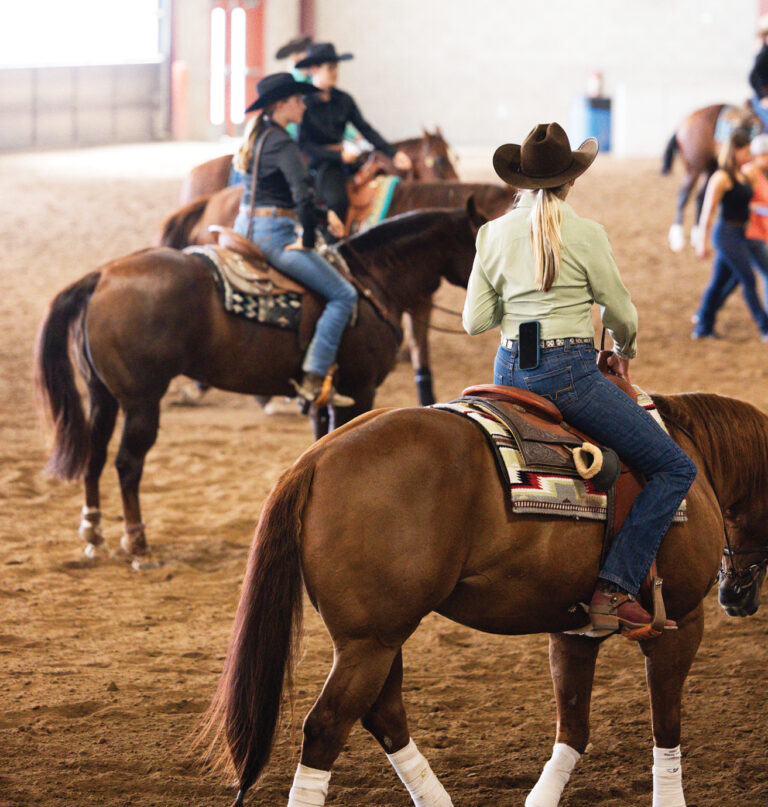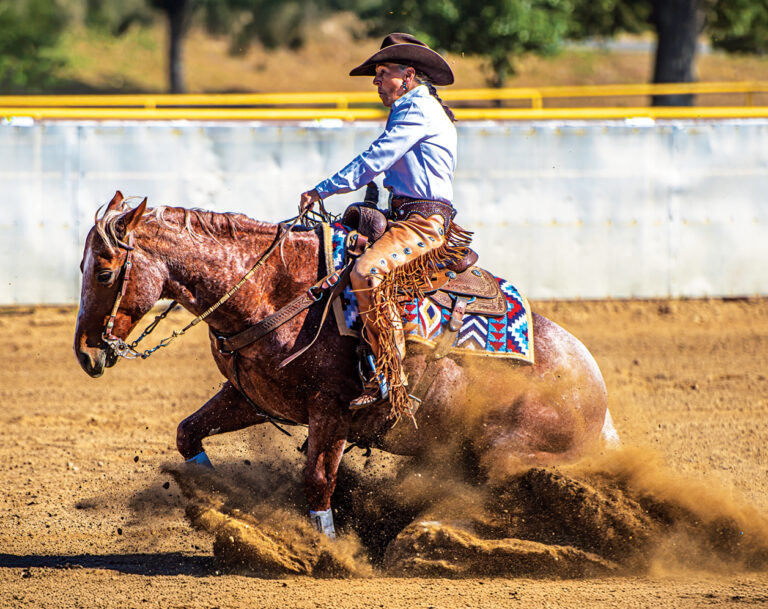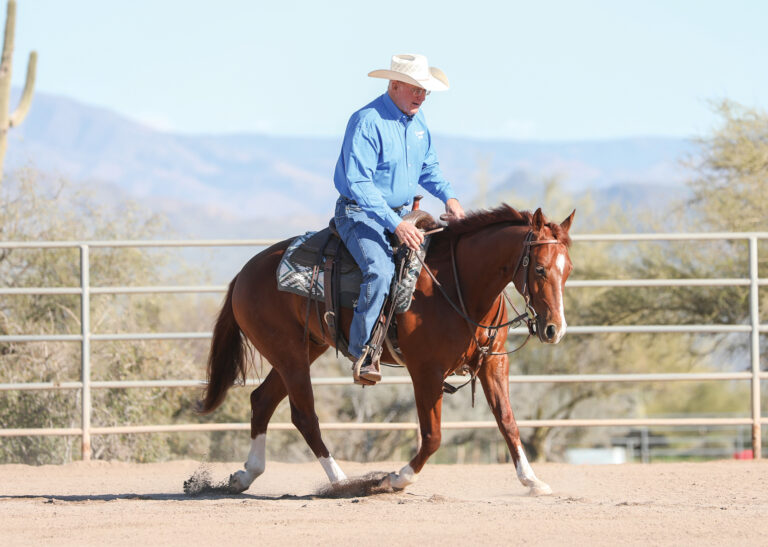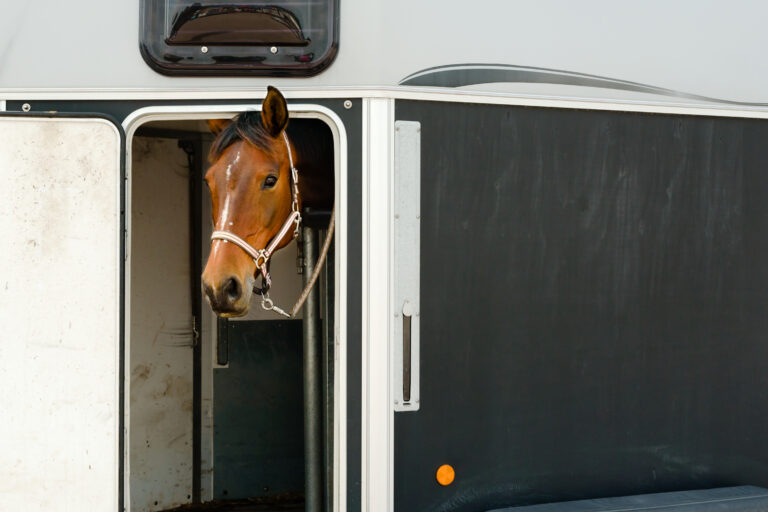Getting the most out of a clinic requires a considerable investment. First, there’s the expense of participating, plus travel and lodging if it’s not close to home. Second: the time. You give up an entire day, weekend, or sometimes week of your life to ride under an instructor you respect. And last, there’s the energy involved in getting ready, attending, and then recovering after long days of riding. So if you’re willing to put forth those valuable resources, you’d better plan to reap the benefits of the experience, right?
[RELATED: GET THE MOST OUT OF A CLINIC]
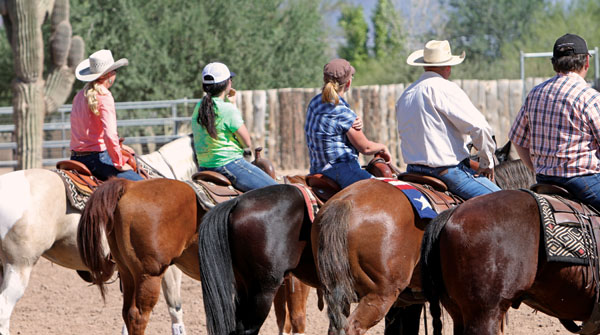
Here we’ll share five riders’ clinic experiences. We’ll examine what they set out to learn; how it turned out; and whether they came away with new approaches, knowledge, skills, and enthusiasm. We’ve also included some tips from clinicians on how to maximize your clinic experience, whether you’re a participant or an auditor.
AQHA TRAIL CLASS TUNE-UP
Rider and discipline: Robin Wyant, Marysville, California; trail class.
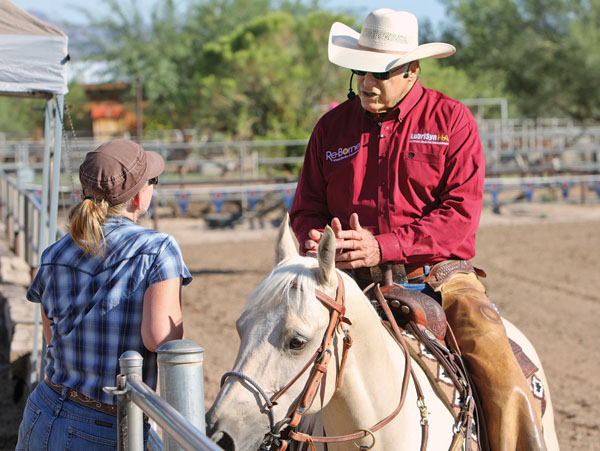
Clinician: Tim Kimura.
Horse: Craklin Impulse, “Crackers,” 14-year-old AQHA gelding.
Goal: Wyant desired insight into the trail course riders completed at the Spring Fling AQHA show in Las Vegas from the course’s designer (Kimura).
The session: The clinic spanned two hours on the morning of show day. “It wasn’t so much Crackers that needed that clinic,” Wyant confides. “Three of us—my trainer, a youth rider, and myself—were entered to show him on the trail course later in the day. We were anxious and excited to take part in a clinic that focused on the exact course we’d all have to navigate.” Wyant’s trainer, Terry Skevington, rode Crackers in the clinic while she and 16-year-old Bailey Newlin observed closely to gain as much as they could. “Tim walked all of us—riders and observers—through the course, spending time at each obstacle and giving us his expectations of how it should best be ridden. Tim’s courses are extremely technical and challenging, but also have flow when ridden correctly. He’s one of the biggest names in course design, and this was a chance that doesn’t come along often for us to learn from him in person.”
Results: Newlin had only been “on course” at schooling shows, so this clinic boosted her confidence and helped teach her how to position her horse, where to hit her marks, and how to get correct striding on this high-caliber course. She used her new knowledge in her AQHA youth trail class later that day and won the class. Skevington won senior, and Wyant won her amateur select class for a clean sweep and proof of the clinic’s value. “All three of us benefited that day and for the future,” Wyant says.
Best takeaway: “The clinic definitely taught me better striding and hitting my marks,” Wyant shares. “I sometimes look too far ahead on course, so this session also taught me to look through the current obstacle but not necessarily all the way to the next obstacle on the course, helping my focus and timing.”
FOUNDATION FOR ANY DISCIPLINE
Rider and discipline: Bailey Thers, Fort Collins, Colorado; foundation work, communication, and problem solving.

Clinician: Ty Brazeal.
Horse: Wildorado’s Serenade, “Sera,” 3-year-old Danish Warmblood mare.
Goal: Thers wanted to introduce her young horse to basic groundwork for a solid foundation for any riding discipline.
The session: This two-day clinic took place at the fairgrounds in Durango, Colorado. Thers is the head trainer at Wildorado Ranch in Durango and thought Sera could benefit from some foundation training via the clinic.
“Sera had never really been off the farm before, and since Ty Brazeal was coming to town, I knew this would be a great opportunity to give her a critical step in her training,” Thers says. “The group included young horses like Sera, but also more advanced horses with problems that needed working through. Ty rode many of the horses to demonstrate his techniques and help the horse learn.”
The clinic incorporated ample groundwork, and Thers says, “I think too many people are missing out on groundwork. It was helpful to start with exercises on the ground, then once we learned techniques and timing, to be able to implement them while mounted. That made it easier on the horse, too.”
Results: Sera presented no unwanted behaviors as she began this clinic, so it served as a learning experience for her, and for Thers to learn more about the horse. “Sera was really well-behaved,” Thers confirms. “We worked on responsiveness to aids, flexion in the neck and poll, and getting her to lift her back.” Sera is now poised for a career as a performance horse.
Best takeaway: Thers has experience taking lessons and training horses, but says, “I benefited a lot from a pressure-and-release exercise that improved my understanding and timing. We practiced it on the ground, then while mounted. I’ve known about the technique for years in working with horses, but Ty really emphasized the specifics of the timing and fine-tuned my abilities. I’ve been able to apply this with other horses since the clinic.”
RANCH RIDING, FROM A JUDGE’S PERSPECTIVE
Rider and discipline: Roxanne Peters, Auburn, Washington; ranch riding.
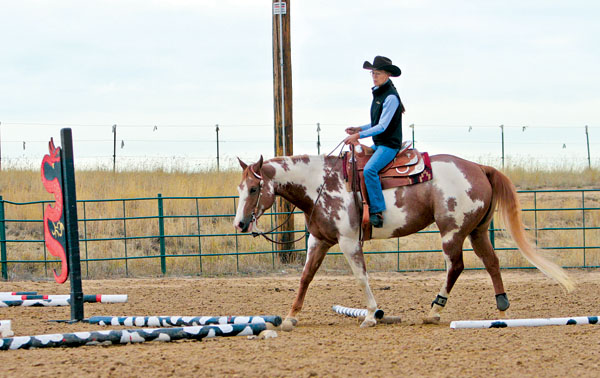
Clinician: Laurel Walker Denton.
Horse: Mity Independent, “Cricket,” 8-year-old AQHA mare.
Goal: Ranch riding is a fairly new class to AQHA shows, and Peters wanted to gain insight into a lack of consistent placing in classes from show to show and add tools to improve performance.
The session: Trainer and judge Denton offered a two-day clinic after judging the ranch riding classes at the 2014 AQHA World Championship Show in Oklahoma City. “On the first day, Laurel demonstrated and lectured using my mare in her introduction to ranch riding, while I listened and took notes,” Peters recalls. “On the second day, I was determined to simulate my show preparation as if I were competing in an AQHA event. I saddled Cricket up early, warmed her up via longeing, used our show equipment (show bridle, saddle, and pad), and even wore a cotton button-down shirt and my show hat.” Many second-day participants were competitive showmen, so it was a more advanced group of horses and riders. “Laurel has laser focus and ranch experience both in the arena and on her ranch in Arizona. She noted what judges look for and put us through our paces. We worked on refining our transitions, preparing our horses for logs, and speed control, plus she drilled us on rider position and becoming teams with our horses.” The clinic wrapped up with a mock horse show, which Denton judged in entirety, scribe and all.
Results: “I tend to want to be perfect all the time,” Peters confides, “so Laurel had me ride another horse through a ranch riding pattern. This helped me understand that I had the talent and was able to ride through an unfamiliar horse’s problems. When I got back on Cricket, I realized not to dwell on a slight mistake or lack of perfection. In doing this, I was able to actually get more extension of my gaits. When I relaxed and softened my hand, my mare got softer in the face as well.”
Best takeaway: “I learned to trust my horse,” Peters says. Her lack of trust translated into stiffness in her hand and arm. “I veered on the side of too much contact, and I tended to correct my horse in advance. Laurel emphasized that more freedom in my arm is more effective and conveys more confidence to the judge.”
REINING REINFORCEMENT
Rider and discipline: Gina Wigen, Rathdrum, Idaho; reining.
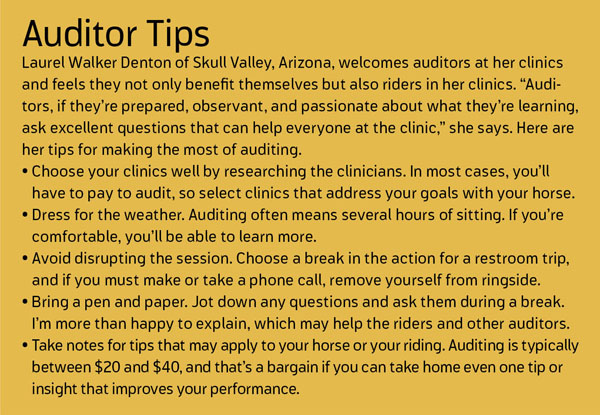
Clinician: Todd Bergen.
Horse: Stelle Estrisce Whiz, “Whiz,” 11-year-old AQHA gelding.
Goal: Wigen wanted to sharpen her horse’s maneuvers to successfully compete in amateur reining at the AQHA World Show.
The session: Held in Sultan, Washington, the clinic consisted of one day of participation and one day of observation. “I’ve been showing successfully in NRHA classes throughout the western U.S. and Canada since 2011,” Wigen shares “Todd had helped me in the past with this horse. This session was a chance for Todd to confirm that I was still on track with what he’d shown me before.” Wigen also notes that she finds watching other participants and their horses as educational as working on her own mount. “Clinics are a great way to learn. You have to be open minded to try new things and to be able to sort out what will work for you and your particular horse.”
Result: Wigen gained confidence and assurance that she and Whiz were on the right track. “It’s good to have someone at the top level in the reining industry see what we’re doing, and how this horse has come along,” she says. “Even though I didn’t have any problems to solve, it’s helpful to confirm our progress and to see Todd work with other horses and riders.”
Best takeaway: “This older horse is pretty consistent,” Wigen asserts. “The clinic gave me an important reminder not to overdo the maneuvers to keep him sharp a few weeks before a competition. A horse that already knows his job will stay fresher if not drilled repeatedly.”
BETTER BARRELS
Rider and discipline: Kym Laroche, Arlington, Washington; barrel racing.
Clinician: Danielle Campbell.
Horses: Miss April Dual, “Pickles,” 5-year-old mare; and First Vintage, “Amos,” 7-year-old gelding.
Goal: Like all barrel racers, Laroche wanted to shave time off her patterns, as well as get an expert opinion on her two horses’ barrel racing abilities.
The session: Larchoche hauled Pickles and Amos for a two-day clinic. She rode Pickles in one session each day and Amos in the other. “Pickles was bred as a cutting horse but didn’t want to cut, and Amos was bred and started as a reining horse,” Laroche shares. “I looked into Danielle’s background and liked what I saw, so I was eager to see what her advice would be for my two horses.” Sessions included talks about technique, hauling tips, and bit and saddle assessment. “Danielle had us send our horses through the pattern to evaluate their style and ability and made recommendations to each rider. I liked that she took enough time with each pair to offer a complete evaluation. While some horses and riders took more time than others, she never rushed anyone or was exclusive with her time. We practiced drills that Danielle uses for her own horses as well as pattern work.”
Result: “Amos had a lot of reining buttons and would wait for rider commands at every step—we could never get enough speed from him,” Laroche laments about the horse’s short stint as a barrel mount. “On the other hand, Pickles, even at only 14 hands, has turned out to be a fantastic barrel horse with many wins. We’re now on the professional circuit, even though I hadn’t dreamed I’d achieve that much with her when I attended the clinic.”
Best takeaway: “Danielle recognized my mare’s unique style,” Laroche shares. “She suggested a snaffle over the sidepull I’d been using. She advised that it’d help my mare snap around her turns better, and it immediately worked.”

